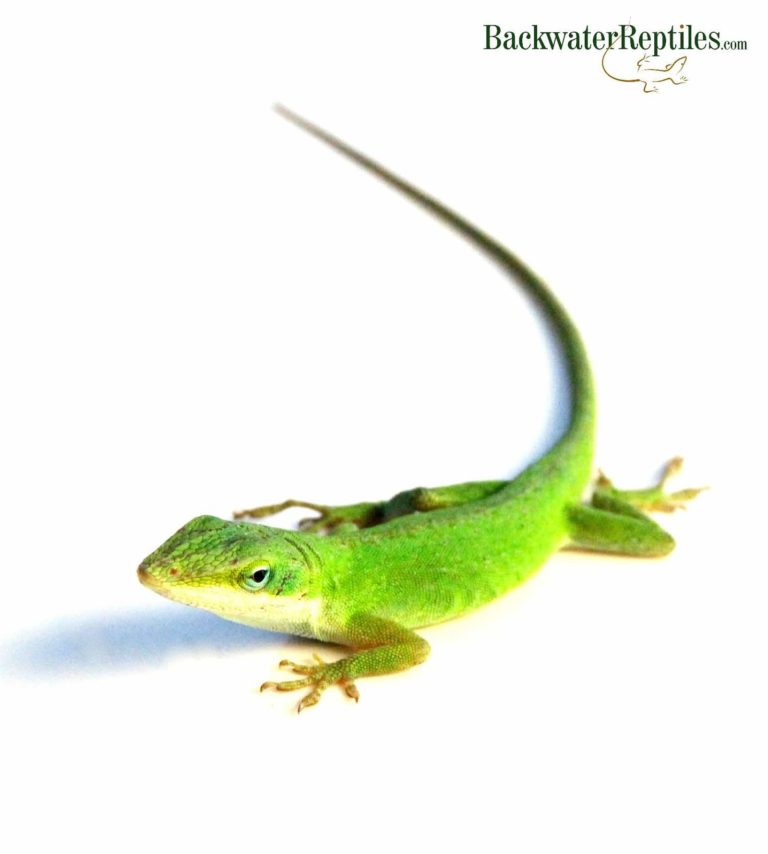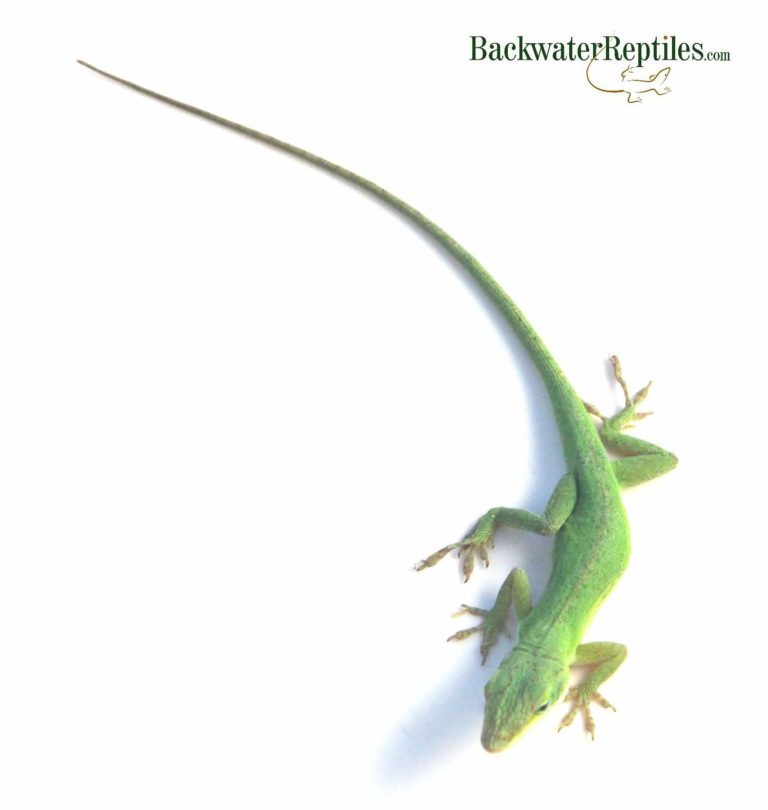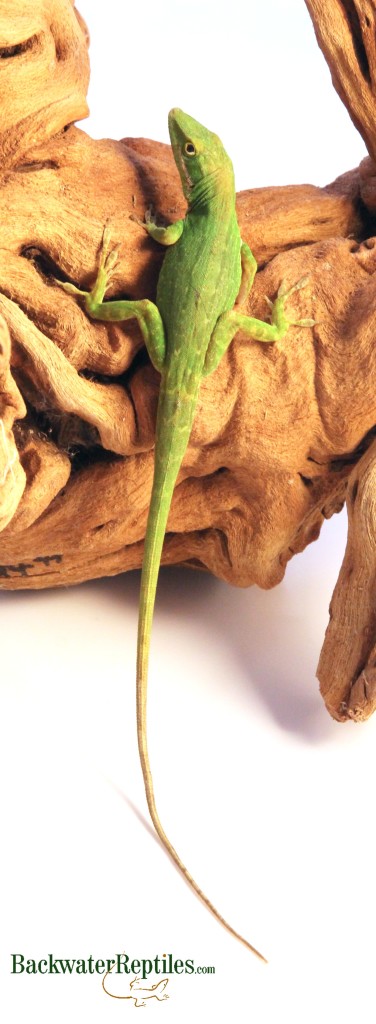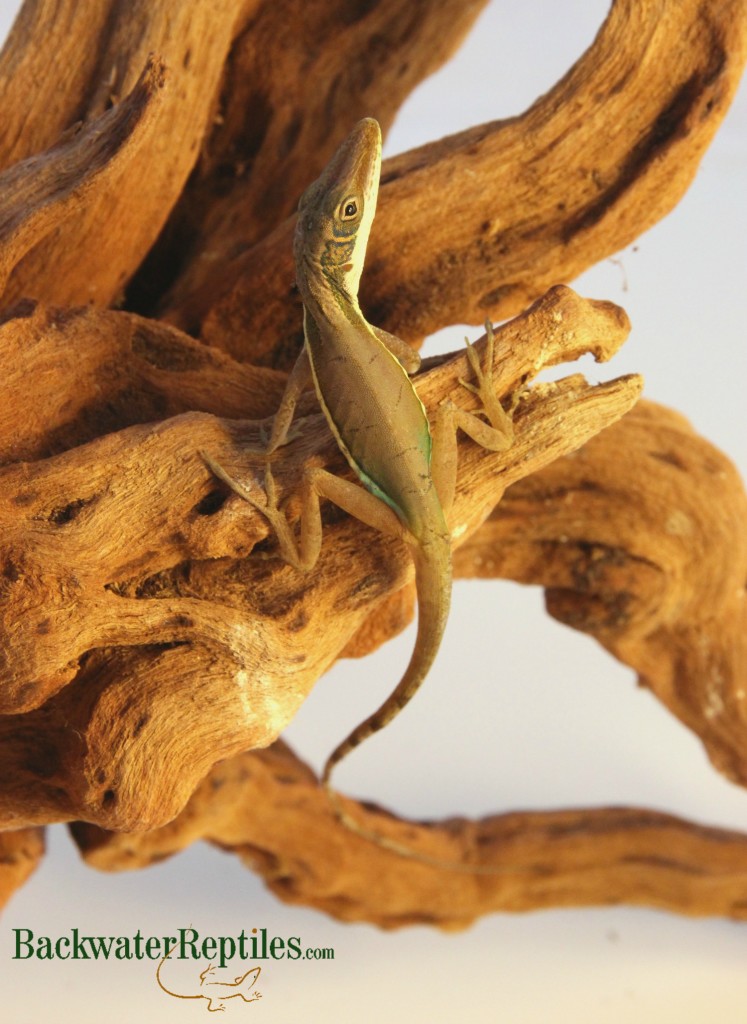Anyone who takes up a hobby or learns a new activity has to begin somewhere, right? Where might that “somewhere” be for reptile enthusiasts and collectors? For many of us, including a good number of the Backwater Reptiles team, the jumping off point was the common Green Anole (Anolis carolinensis).
We often recommend Green Anoles to parents who are looking for a simple pet with relatively easy care requirements. They are excellent pet lizards for young children.
In this article, we’ll touch upon many of the reasons why we feel that Green Anoles are such excellent starter reptiles. We’ll also dive into their care requirements so that anyone interested in owning their first Green Anole will know what to expect.

Why Green Anoles?
Because Green Anoles are so common, they are often overlooked by many reptile enthusiasts. However, Green Anoles are vibrant little lizards with bright green coloration. Males also have dewlaps that are pinkish in color, making them aesthetically pleasing pets. We’re also quite fond of their long, skinny body shape and large, triangular heads.
As we’ve already established, it’s not hard to come by Green Anoles. They are sold at virtually all large retail pet stores as well as small, independently owned pet stores. It’s also pretty much unheard of for a Green Anole to carry a price tag that is more than ten dollars.
We also feel comfortable recommending Green Anoles to first time reptile owners because of their small size. Mature male Green Anoles typically don’t get longer than eight inches and females usually max out around five or six inches long. Half of that length is the lizard’s tail, so these are most certainly pets that stay a manageable size.
Manageable size means manageable cage size as well. Green Anoles don’t need a forty gallon tank to call home. Enclosures of a modest size are the way to go when keeping a single anole – just be sure that your anole also has all the other requirements for staying healthy. Don’t worry if you’re note sure what that entails. We’ll discuss caring for your Green Anole in the next section of this article.
Green Anoles are a species with pretty simple care requirements, however many of those care requirements will hold true for other species of reptile as well. This means that first time Green Anole owners can learn the basics of what reptiles need in captivity simply by caring for their first tiny pet lizard. We’re also of the opinion that it’s a great way for kids to learn about the responsibilities of pet ownership, even if their pet is not a typical furry companion.

Caring for Your Pet Green Anole
Green Anole Size and Life Span
We’ve already established that Green Anoles stay small and don’t get longer than eight inches, tail included. However, we did not touch upon their life span in captivity.
With proper husbandry and care, Green Anoles tend to live anywhere between three to six years. While this might not seem like very long, in the wild, they rarely live beyond three years old due to predators and other factors.
Feeding and Watering Your Green Anole
Like many species of lizard, Green Anoles are insectivores, which means that they eat invertebrates. In captivity, they thrive on a diet of vitamin dusted crickets, roaches, and soft-bodied worms such as wax worms.
The best method to ensure that your Green Anole is properly hydrated is to mist the enclosure daily so that water droplets accumulate on leaves and cage decor. In the wild, anoles will lap water that collects on leaves and plants, so replicating this behavior is your safest bet.
Many Green Anole owners also provide a water dish for their pet. While it is not unheard of for anoles to drink water from a dish, there is no guarantee that any particular anole will do so, which is why we recommend making sure there is moisture collecting on the leaves in your anole’s cage.
Another word of advice when it comes to having a water dish in your anole’s cage: Make sure that the dish is shallow enough that if your anole unintentionally climbs in, it can escape with no issues. A water dish that is too steep could result in accidental drowning. You can also place a stick or other object in the water dish that allows the anole to climb out if it finds itself going for an accidental swim.

Habitat Requirements for a Green Anole
Green Anoles are arboreal lizards, therefore terrariums that provide more vertical space as opposed to horizontal space are highly encouraged. This will also make it easier to put plants and vines (real or fake) inside the tank for your anole to climb on.
As with many tropical lizard species, ventilation is very important when it comes to housing. We recommend an enclosure that has at least one screen wall. This should help maintain proper humidity and moisture levels without allowing fungus or mold to grow.
Plants, vines, and other vertical cage furniture is extremely important to the health of a Green Anole. Since they are arboreal and spend most of their time in trees in the wild, it is a necessity that your anole has places to hide and conceal itself. It is highly unlikely that your anole will get much use out of a hide space placed on the bottom of the cage.
For a single Green Anole or a breeding pair, we recommend a twenty gallon tank. This size typically provides enough room to accommodate the activity level of both lizards and will also allow for the proper temperature gradient needed in the cage.
Green Anoles are lizards that bask a lot and require full-spectrum UV light for eight hours a day. It is acceptable to turn the light off at night to mimic natural nighttime/daytime cycles.
Ambient cage temperature should be around eighty degrees Fahrenheit or so. The basking area should be around eighty-five to ninety degrees. The cool side of the enclosure should remain in the mid 60s/70s. Humidity levels should be approximately sixty to seventy percent.
The best type of substrate to put in your Green Anole’s cage is something that holds moisture but will not remain super wet. We recommend coconut husk or organic potting soil.
Handling Your Green Anole
While Green Anoles might not be the most friendly lizard, they can be handled. We do recommend that children be closely supervised when interacting with a pet anole as it can be stressful to the lizard to be gripped too tightly or petted too much.
Green Anoles are not aggressive, although you might see males bob their heads and show their throat pouches in territorial displays. This is a species of lizard that rarely bites. An anole would much rather run from you than fight you.
If you do want to have an interactive pet Green Anole, we recommend allowing the lizard to climb and perch on your hand rather than holding it captive. This will ensure that the anole does not feel threatened or stressed and will also give you the opportunity to better view how pretty your pet anole is.
Avoid rough handling or grabbing the anole too tightly in a single hand. While they are tough lizards, they will lose their tails if they feel too endangered or stressed. The key to handling a pet Green Anole is to be gentle. Make slow movements and remain calm so that your anole will feel at ease.
If you find that your anole is particularly skittish, we recommend holding it inside the cage so that just in case it runs, jumps, or hops off your hand, it will land in a safe place. Nobody (lizard or human!) wants to have to chase or be chased around the house after an accidental handling mishap. Once your anole is accustomed to your presence inside the cage, it will become safer to hold it outside the cage.

Conclusion
Many of us have stories from our younger days of getting our first Green Anole from the pet store and joyfully creating an enclosure for the little lizard.
Share your first Green Anole story in the comments! We’d love to hear your tales of these great little starter reptiles.
If you are considering a Green Anole as a starter reptile for yourself or a family member, Backwater Reptiles does have them for sale. And as with all of our animals, we offer live arrival and seven day guarantee within our guarantee terms.




